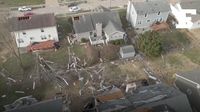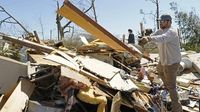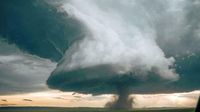Devastation swept through several U.S. states over the weekend, as severe weather conditions warranted the release of tornado warnings and emergency responses. Beginning on Friday, March 14, 2025, violent tornadoes and storms struck the central and southern regions of the United States, resulting in tragic consequences.
Reports indicate at least 40 fatalities have been confirmed so far, with many more individuals suffering injuries from the catastrophic events. The states hardest hit include Missouri, which bore the brunt of the devastation, with 12 lives lost as homes were destroyed and landscapes were ravaged. By Saturday evening, over 250,000 households were reported to be without power, according to the site Poweroutage.
On Sunday, March 16, 2025, former President Donald Trump addressed the disaster on his platform Truth Social. “We are closely monitoring the tornadoes and devastating storms affecting several southern and Midwestern states,” Trump stated, underscoring the federal government’s readiness to support local recovery efforts. He confirmed the deployment of the National Guard to assist Arkansas and other severely affected areas.
“The damage is overwhelming,” exclaimed Missouri Governor Mike Kehoe after assessing the destruction firsthand. “Homes and businesses have been demolished, entire communities are without power, and the rebuilding process will prove difficult.” His sentiments resonate with the residents as they grapple with recovery efforts amid widespread destruction.
The chaos did not stop there. The violent weather also birthed blinding dust storms and wildfires. For example, severe dust conditions caused accidents, resulting in eight fatalities on Kansas highways during multi-vehicle accidents. Further, fires swept through Oklahoma, damaging over 400 homes. Mayor Will Joyce of Stillwater reported losing at least 74 homes to raging flames fueled by wind.
Local authorities confirmed multiple deaths across various regions: six lives were claimed in Mississippi, four individuals perished due to multiple fires raging through Oklahoma, and three deaths were reported from Arkansas. The urgency for support was palpable through community efforts, as families and volunteers worked together to clear debris and salvage belongings—clothing, photographs, and toiletries—from the wreckage.
Elizabeth Johnson and her family shared harrowing tales of survival. They sheltered inside their vehicle, praying as their home was torn apart around them. “We could only hold on and hope for the best as the roof collapsed over us,” Elizabeth relayed. This sentiment echoed across countless families who faced similar circumstances, raising the communal spirit during these desperate times.
Despite rising fears, meteorologists warn these extreme weather patterns are not currently unusual for this time of year, pointing to previous instances of abrupt tornado formation during March. Yet, the weather impact intensity does evoke concerns among scientists. It has been reported by the National Oceanic and Atmospheric Administration (NOAA) nearly 1,800 tornadoes occurred throughout 2024 alone, marking the second-most quantitatively impactful year since 2004.
Devastated Mississippi continues to rally support for over 200 displaced individuals from tornado stricken counties, with efforts being made to rescue trapped individuals and deliver necessary supplies. A local resident, Dakota Henderson, shared his sobering experience rescuing trapped neighbors, recalling discovering five lifeless bodies among the ruins of his aunt's home—a poignant reminder of tragedy's cruel grip.
The grave circumstances have shaken the nation, prompting responses not just localized for emergency aid, but igniting broader discussions on climate change’s role. The intense weather fluctuations observed lead many to question the increasing frequency and severity of such occurrences, especially as communities continue to adapt to their new realities post-disasters.
At the frontline of these discussions, policymakers are being urged to take action toward sustainable practices aimed at mitigating the devastating impacts of climate change. The dangers are evident—increased tornado occurrences and the period of destruction highlight the need for strategic disaster preparedness and compassionate community care.
With reconstruction efforts dominating the immediate future, citizens are urged to support local relief companies providing necessary supplies and assistance. Only through coupled community efforts and support can there be hope for recovery and revitalization.
The heart of America remains strong as people unite to support one another. Although the devastation is immense, the resilience and dedication displayed by the communities promise recovery efforts will not be forgotten. Together, they will navigate this storm's aftermath and emerge stronger, implementing improved measures for future resilience against nature’s fury.




